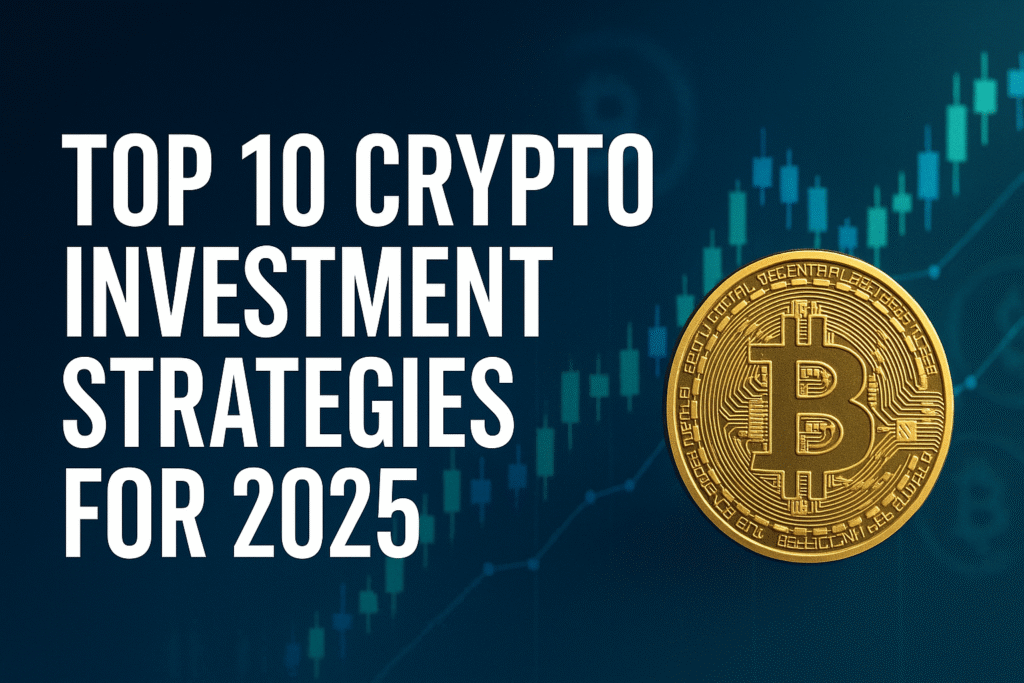Cryptocurrency markets keep evolving rapidly. Below are ten practical investment strategies tailored for 2025 — each summarized with what it is, why it matters now, risks, and quick implementation tips. This is educational information, not financial advice; do your own research and consider consulting a licensed advisor.
1) Dollar-Cost Averaging (DCA) into Blue-Chip Crypto
– What: Regularly buy a fixed fiat amount of major assets (e.g., Bitcoin, Ethereum) regardless of price.
– Why 2025: Reduces timing risk in a still-volatile market and works well when macro and regulatory environments remain uncertain.
– Risks: Slow to capture rally tops; still exposed to long-term declines.
– How-to: Set weekly or monthly buys via exchange or broker; automate transfers and purchases.
2) Core-and-Satellite Portfolio Construction
– What: Keep a conservative “core” (BTC, ETH, stablecoin yield) and small “satellite” positions in higher-upside altcoins, DeFi, L2s, or thematic bets.
– Why: Balances long-term safety with upside potential.
– Risks: Satellites can be highly volatile and illiquid.
– How-to: Example allocations — conservative: 80% core / 20% satellite; balanced: 60/40; aggressive: 40/60. Rebalance quarterly.
3) Staking and Liquid Staking Derivatives (LSDs)
– What: Earn yield by staking proof-of-stake tokens directly or via LSDs (e.g., stETH-like tokens) that keep liquidity.
– Why: Post-merge Ethereum and many PoS networks offer steady yields; LSDs let you use staked exposure in DeFi.
– Risks: Slashing risk, smart contract risk for LSDs, counterparty risk, yield variability.
– How-to: Use reputable staking providers or run validators if qualified; prefer audited LSD platforms; monitor validator performance.
4) Selective Yield Farming and Liquidity Provision
– What: Provide liquidity or farm yields in DeFi to earn rewards.
– Why: High yields remain attractive, especially in newer chains and DEXs.
– Risks: Impermanent loss, rug pulls, smart contract exploits, token emissions leading to dilution.
– How-to: Focus on deep pools (stable/blue-chip pairs), use audited protocols, limit exposure per pool, impermanent-loss-protected products, and harvest rewards periodically.

5) Layer-1 and Layer-2 Infrastructure Bets
– What: Invest in promising L1/L2 networks and infrastructure tokens (scaling protocols, oracles, rollups).
– Why: Scaling and composability are central to future adoption; rollups and alternative L1s will compete.
– Risks: Technical and adoption risk, regulatory scrutiny if token economics are questionable.
– How-to: Research developer activity, TVL, tokenomics, partnerships, and upgrade roadmaps.
6) Diversified Crypto Indexing and ETFs
– What: Use crypto index funds or ETFs (where available) to get diversified exposure.
– Why: Easier, lower-maintenance way to track broader sector performance and reduce single-token risk.
– Risks: Management fees, index composition may lag innovation, limited availability by jurisdiction.
– How-to: Choose funds with transparent methodologies and low fees; consider on-chain index tokens like DPI (or regulated ETFs where accessible).
7) Opportunistic Trading with Risk Controls
– What: Short-term strategies (swing, momentum, mean reversion) using technicals and on-chain signals.
– Why: Increased institutional participation creates tradable trends and volatility.
– Risks: High transaction costs, emotional bias, leverage can amplify losses.
– How-to: Use position sizing rules (max risk per trade), stop-losses, and backtest setups. Avoid excessive leverage.
8) Cross-Chain and Interoperability Plays
– What: Invest in protocols solving cross-chain liquidity, messaging, and security (bridges, routers, cross-chain DEXs).
– Why: Interoperability is critical as assets move across ecosystems.
– Risks: Bridges are frequent targets for hacks; complexity raises systemic risk.
– How-to: Favor projects with strong security track records, audited bridges, and multi-sig guardians or decentralized validation.
9) Regulated Exposure via ETFs, Futures, and Structured Products

– What: Use regulated vehicles (spot ETFs, futures, structured notes) for on-ramp, simplified tax reporting, and institutional-grade custody.
– Why: Regulatory acceptance continues to grow, offering safer access for many investors.
– Risks: Tracking error, management fees, and product complexity.
– How-to: Compare products for fees, custody arrangements, and liquidity. Understand settlement and margin mechanics for futures.
10) Thematic and Early-Stage Allocations (AI, Web3, Gaming, Privacy)
– What: Allocate a small percentage to thematic tokens and early-stage projects aligned with long-term secular trends (AI-blockchain integrations, gaming/metaverse, privacy).
– Why: These themes could deliver outsized returns if adoption accelerates.
– Risks: High failure rate, hype cycles, regulatory risk (especially around privacy and gaming economies).
– How-to: Do deep due diligence on teams, roadmaps, token utility, and user metrics. Consider venture-style holdings with multi-year horizons.
Risk Management and Position Sizing
– Never risk more than you can afford to lose. Common rules: 1–5% of capital risk per trade and 5–20% allocation to high-risk satellites.
– Use stop-losses, position limits, and maximum portfolio drawdown rules (e.g., reduce risk if portfolio down >20%).
– Diversify across chains, strategies, and custody types to reduce single-point failures.
Security and Custody Best Practices
– Use hardware wallets for long-term holdings; enable passphrases and secure backups.
– Split custody: keep a portion on cold storage, another in reputable custodial services for active use.
– Use multisig for sizable holdings when feasible; minimize approvals for smart contracts; use audited contracts only.
– Beware of phishing, social engineering, and fake dApps.
Tax, Regulation, and Compliance
– Keep detailed transaction records (buys, sells, swaps, staking rewards, airdrops).
– Be aware of local tax treatment for staking, yield farming, and NFTs.

– Expect continued regulatory scrutiny in 2025; prioritize compliant platforms and consider reporting obligations.
Practical Implementation Steps
1. Define time horizon and risk tolerance.
2. Build a core allocation (BTC/ETH/stable yield) and decide satellite percentage.
3. Automate DCA and staking where possible.
4. Use analytics tools (on-chain metrics, developer activity) to vet projects.
5. Rebalance quarterly and review thesis for each holding annually or after material events.
Sample Portfolio Templates (illustrative only)
– Conservative (long-term saver): 70% BTC/ETH, 20% fiat-stable yield, 10% diversified ETFs/indexes.
– Balanced: 50% BTC/ETH, 20% staking/LSDs, 15% DeFi/L2s, 10% thematic, 5% cash/stable.
– Aggressive: 30% BTC/ETH, 30% altcoins/L2s, 20% DeFi farming/liquidity, 10% thematic early-stage, 10% stable for opportunities.
Key Metrics & Tools to Track
– On-chain: active addresses, TVL, token flows, exchange inflows/outflows.
– Market: liquidity, order book depth, funding rates.
– Developer: GitHub commits, number of projects, grant activity.
– Sources: CoinGecko, Messari, Glassnode, DeFiLlama, Etherscan, Nansen, protocol dashboards.
Closing notes
– Crypto investing in 2025 combines mature areas (BTC/ETH, regulated products) with fast-moving innovations (L2s, LSDs, cross-chain). Blend steady, proven strategies with small, well-researched speculative bets.
– Reassess allocations as technology, macro, and regulatory landscapes change. Keep security, record-keeping, and risk controls as core parts of your process.
If you want, I can: draft a sample portfolio tailored to your risk tolerance and capital, or walk through step-by-step how to set up automated DCA and staking with recommended service types.

